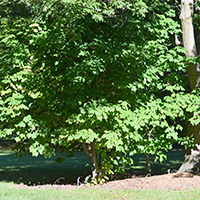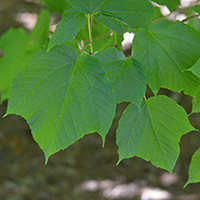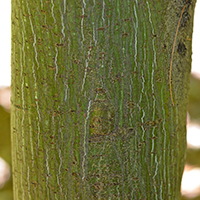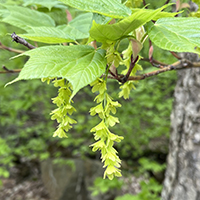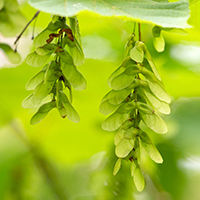What striped maple looks like
Size and shape
- Small understory tree.
- Reaches 10 metres high.
Leaves
- Wide leaves with 3 main lobes.
- Leaves turn yellow in the fall.
Bark
- Distinct green and white striped bark.
Flowers
- Yellow-green flowers hang in clusters.
Fruit
- Winged seeds (samaras) that hang in long clusters.
- Seeds mature in the fall.
Where striped maple is found
Striped maple grows across Central and Southern Ontario, from Norfolk County east to the Ontario-Quebec border and north to Sault Ste. Marie. It is found in damp woods, ravines and on north-facing slopes in more southern climates.
What you need to know to grow striped maple
- Moisture: grows best in evenly moist soils.
- Shade: grows best in full to partial shade; grows poorly in hot summer sun.
- Soil: grows best in well-drained, slightly acidic soils.
- Note: Striped maple is a useful understory species when mature trees provide shade and cool soils below.
- Cautions: Striped maple is also called moosewood because moose and deer love to eat the twigs in winter. Unless you are planting to provide food or browse for wildlife, protect young striped maple trees with netting or burlap until they are tall enough that moose and deer cannot reach the branches.
Benefits and uses of striped maple
Wildlife benefits
Striped maple is a food source for many mammals, including deer, moose, rabbits, beavers and porcupines. It can also be a food source and habitat for birds.
Commercial uses
Wood from striped maple is used for:
- pulp
- veneer
- cabinetry
Fun facts about striped maple
- The green stripes on young bark of striped maple allow it to photosynthesize better in the shade, even before the leaves appear in spring.
Updated: January 10, 2024
Published: July 18, 2014
